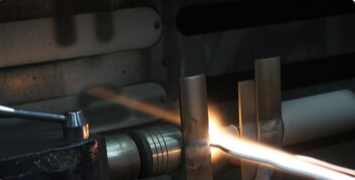

current position:Information and data>Defects and preventive measures of thermal spraying
Defect Prevention Measures for Thermal Spray Coatings
1. Coating peeling and peeling

①The surface roughness is not enough or there is dust adsorption, which reduces the adhesion of the spray coating; the surface roughening of the workpiece and the cleaning before spraying should be strengthened.
②The workpiece contains grease, and the grease overflows during spraying, such as the crankshaft of ductile iron; strictly remove the grease before spraying, and properly bake it.
③There are visible oil and water in the compressed air; try to reduce the oil and water in the compressed air, and repair or replace the compressed air device if necessary.
④The spray gun is too far from the workpiece, and the metal particles are not fully fitted with the workpiece; the distance between the spray gun and the workpiece should be shortened.
⑤ The time interval between turning and brushing, brushing and spraying is too long, and there is oxidation on the surface of the workpiece to be sprayed; the time interval between processes such as surface pre-adding, surface roughening, and spraying depth should be shortened.
⑥ When the spray coating is processed by grinding machine, an alumina grinding wheel is used, so that the coating is partially overheated and oxidized; the grinding wheel should be correctly selected to take cooling measures.
⑦The flame of the spray gun is not concentrated or deflected, so that the metal particles cannot be strongly adhered to the surface of the workpiece; the spray gun should be repaired or replaced.
⑧The linear speed of the workpiece and the moving speed of the spray gun are too slow, and the inclusions float on the surface of the workpiece during the spraying process, which reduces the adhesion strength; the linear speed of the workpiece should be adjusted to control the floating objects between the spraying rooms.
2. Coating layering
①Gap spraying is used. When the standard size is reached, the spraying stop time is too long. Note that when spraying in the gap, the stopping time of each spraying should be short.
②When spraying, the oil and water in the compressed air splashed on the surface of the workpiece; check whether the air compressor and accessories work normally, and often discharge water, especially the oil-water separator should work normally.
③After each layer is sprayed, a large amount of dust is adsorbed on the surface of the workpiece, so that there is isolation or partial isolation between layers; attention should be paid to keep it clean when spraying, and take necessary dust-proof measures.
3. Coating chipping
①When spraying, the spray gun moves too slowly, so that the coating is too thick at one time and overheating occurs; the normal speed of the spray gun should be maintained, and do not spray too thick at one time.
②When spraying, the spray gun is too close to the surface of the workpiece, causing the coating to overheat; the distance between the spray gun and the surface of the workpiece should be properly opened.
③The shrinkage rate of the spraying material is too large or contains a lot of elements (such as S, P, etc.) that cause hot cracks; appropriate spraying materials should be selected, and attention should be paid to minimize the content of harmful elements.
④The current is too large during arc spraying, and oxidizing flame is used during flame spraying to oxidize the thickness of the coating; the spraying parameters and spraying flame should be selected reasonably.
⑤ The sprayed coating rapidly cools and leads to cracking; when spraying a thick coating, attention should be paid to the cooling speed.
⑥ There is oil mist and water in the compressed air, which reduces the bonding strength of the deep layer; the oil and water in the compressed air should be solved in time.
⑦ The rotation center of the workpiece is not accurate, the spray layer is thick or thin, and the shrinkage is uneven during cooling; the concentricity of the workpiece rotation center should be adjusted and repaired.
4. The coating is not wear-resistant
①The spray gun is too far from the workpiece, the temperature of the metal particles is low, and the bonding force with the surface of the workpiece is small, and some of the particles fall off during work; the spraying distance should be selected reasonably.
②There are a lot of sand particles embedded in the coating during lap cutting; the grinding wheel should be selected reasonably.
③The wire feeding is too fast; the wire feeding speed should be selected reasonably.
④ The wire material itself is not wear-resistant; a qualified spray material should be selected.
⑤The air pressure is too low, the spray gun is too far from the surface of the workpiece, which reduces the bonding strength; the spraying parameters should be selected reasonably
Hot information

